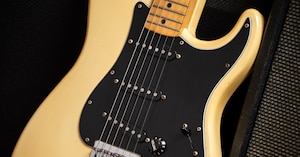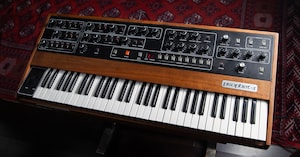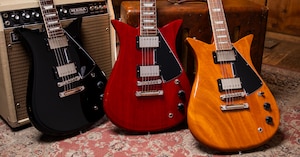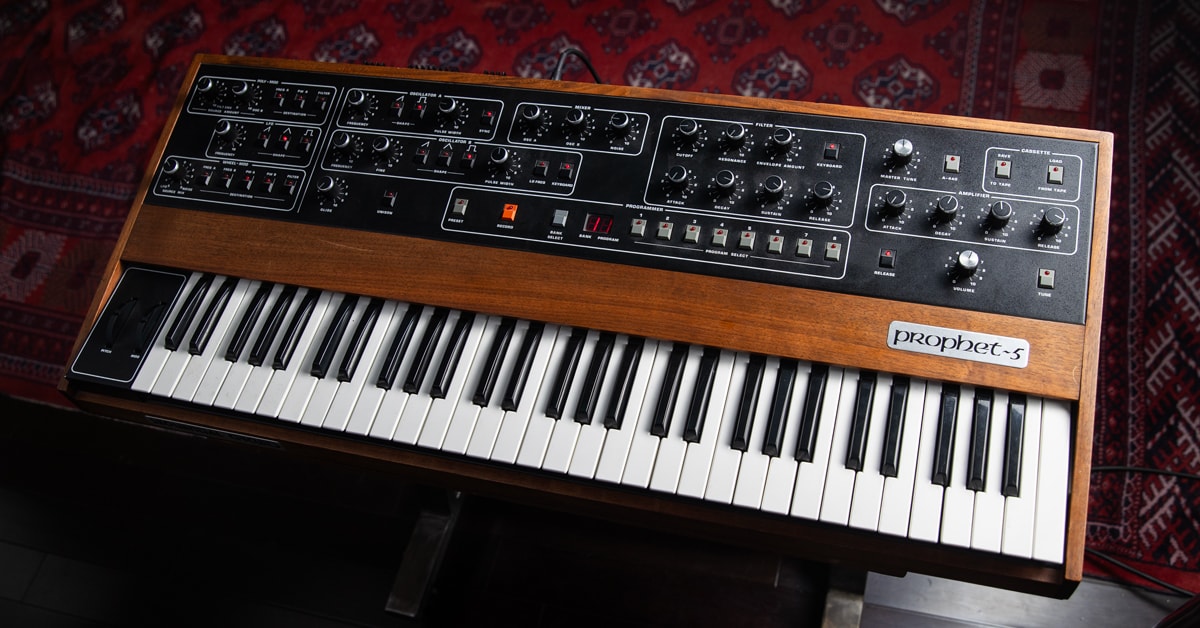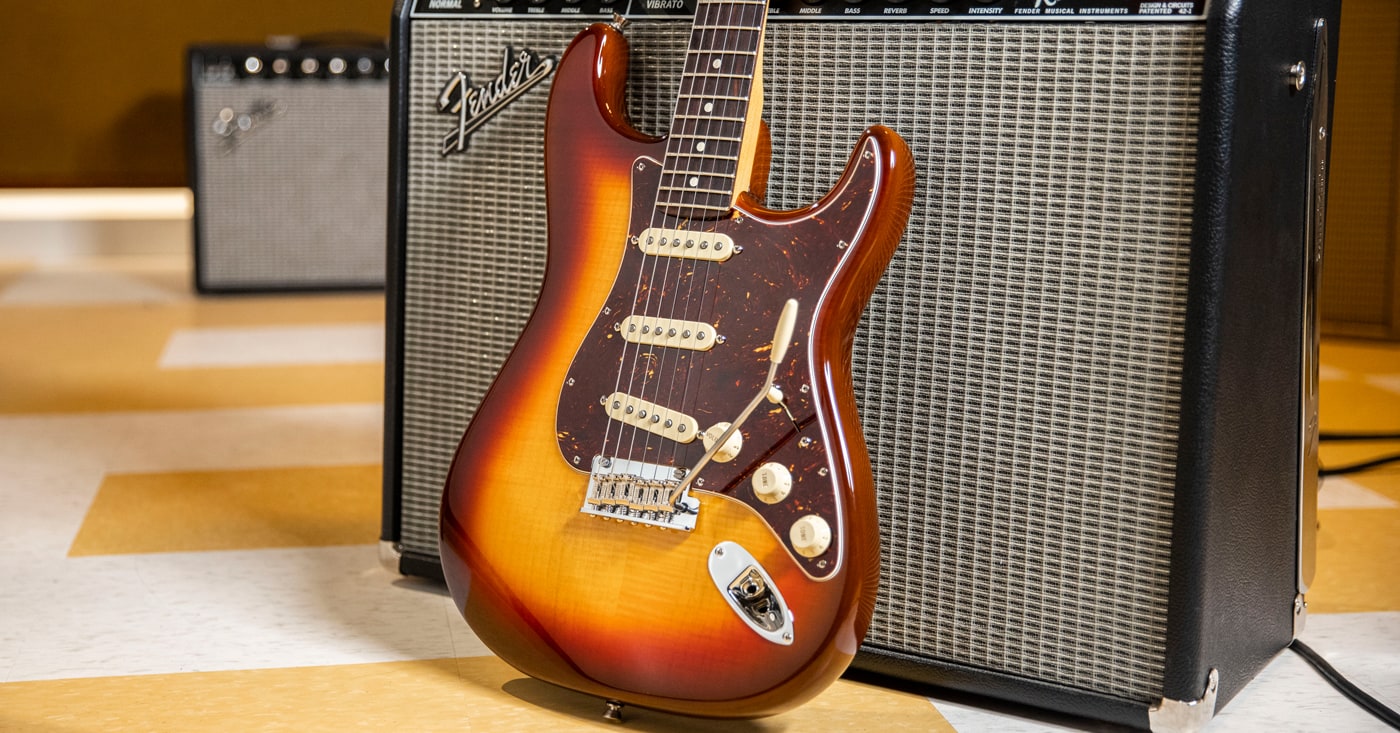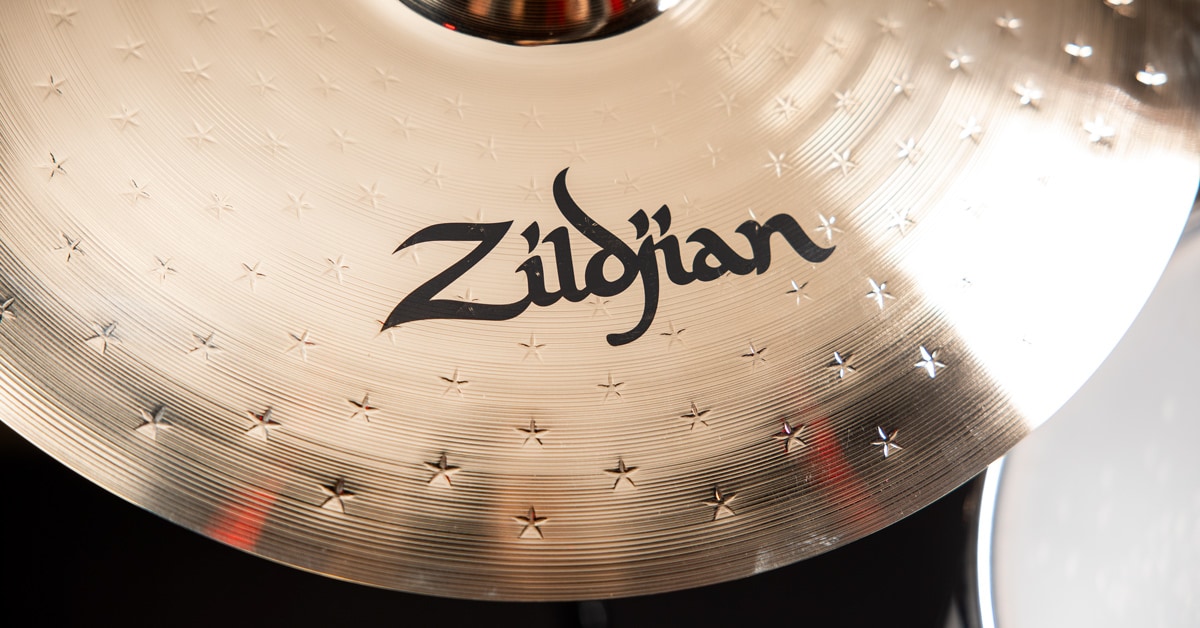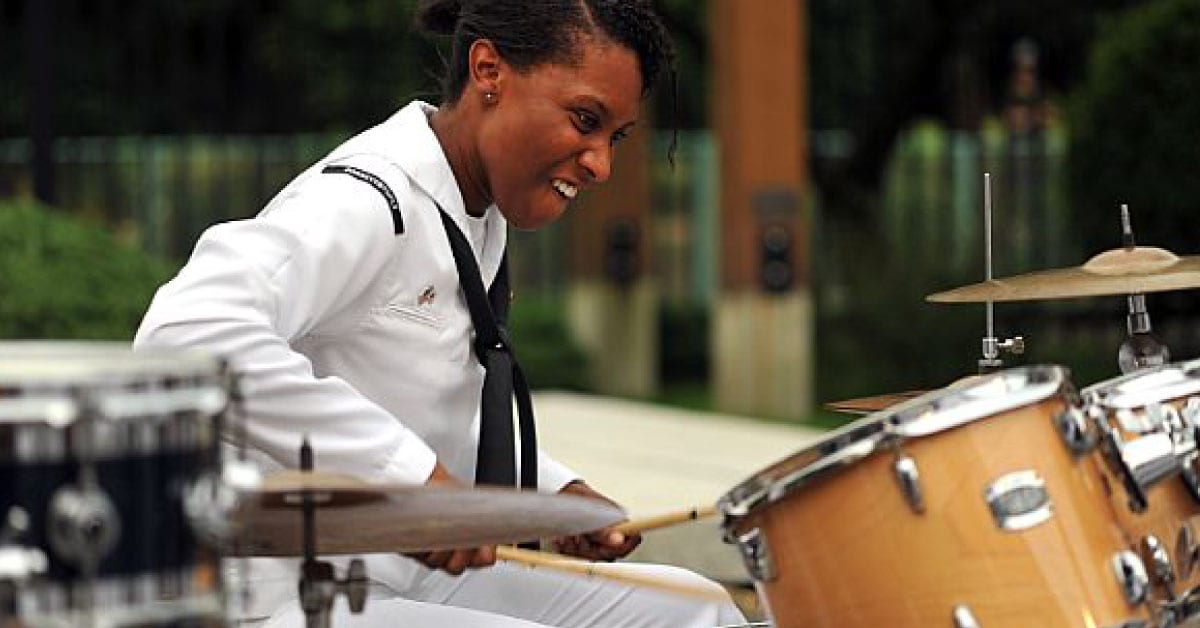What does Camellia Akhamie Kies have in common with John Coltrane, Steve Gadd, Bill Evans, Dave Brubeck and legendary jazz drummer Philly Joe Jones? They are all among the many incredibly talented musicians who cut their performing teeth in U.S. military bands. Akhamie Kies wanted to be a drummer from the very first time she heard her cousin play drums in church, when she was just five years old. The drive and persistence with which she has pursued that aim has made her one of social media’s most popular musical stars and a seriously accomplished percussionist.
After six years touring with the Navy Band, living in a small space while attending college forced her to develop compact, non-traditional drum kits for practice. Turning necessity into innovation, she has used this as a jumping-off place, incorporating hybrid setups with Roland and Alesis drum modules and pads, cajons and other percussion instruments to develop a highly personal style that crosses genres and blends musical traditions.
When did you realize you wanted to become a drummer?
I was five years old the first time I heard the drums being played, and I instantly knew that was my instrument—that was my voice. I was in church, and I looked over at my cousin, who was playing—one of my first memories—I was like, “That's what I'm gonna do.” The vibrations from the drum just resonated with me, and I felt like, “Wow, we are on the same frequency.” And I loved it.
When did you actually start playing?
I started asking for a drum set then, when I was about five years old. But it wasn't the right time. We didn’t have the space for it, and every single year, constantly, it was “Can I get a drum set? Can I get a drum set? Can I get a drum set?” I still remember, I went to my mom. She was standing in the kitchen, washing the dishes, and I asked her. I was like, “Can I get a drum set?” She said “Sure. Go print out the information and bring it to me.” And I was just like, “What?” I was so excited, and, finally, the drum set came.
Were you a diligent student?
I would practice for hours. I spent lots of time behind the drum set just practicing and working on my craft. And after I finished high school, I was able to audition and be accepted into the military band I believe because of all the practicing.
How did you end up in the Navy Band?
After I graduated high school, I knew I wanted to play drums professionally. I wanted to go to school and further my education. I wanted to travel, and I wanted to make money doing what I loved. After I found out that I could do all that while serving my country in the United States Navy, I was like, “Where do I sign?”
What was that whole experience like?
It was my dad, actually, who told me, “Hey, look into the Navy.” I remember going home and Googling “Navy band” or “Navy music.” I looked at the audition requirements. I was still taking lessons with Myles Overton III, from the U.S. Army Band “Pershing’s Own,” and we looked at the material together. He said, “Oh, yeah. You can totally do this.” And I was like, “Awesome.” Rudiments, mallet percussion, drum set—they wanted to hear all of that with a fairly high level of proficiency you were expected to achieve. I auditioned, and I did a great job. The next thing I know, I was heading into boot camp. After that, I ended up at the Navy School of Music, in Little Creek, Virginia. It was a really intense six months of ear training, piano and, of course, drum lessons, but it prepped me to be able to go out and serve in the actual Navy Band.
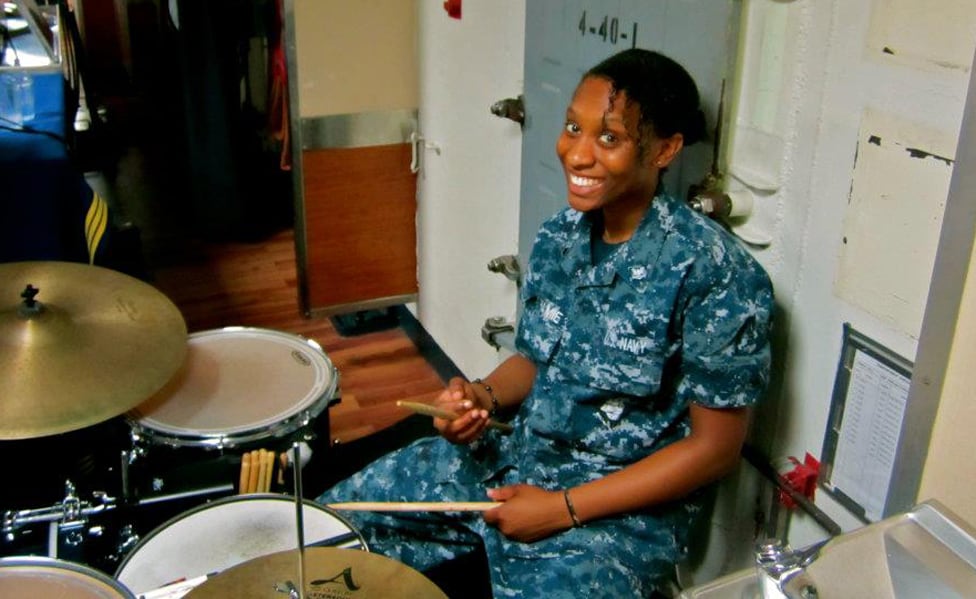
Where were you stationed, and what was that like?
My first duty station was in Yokosuka, Japan, and it was truly an amazing experience. I learned so much about culture, diversity and music. Traveling all over Southeast Asia really just opened up my mind to endless possibilities. I came back to the U.S. thinking, “We can do anything. We can travel anywhere. It's all up to me.” Just having the idea or having the goal. You can do it. And those ideas formed from being in the military and really digging deep into discipline and teamwork. I served for six years, and it was a really great experience.
How did your unique approach to drum kits evolve?
My husband and I were living in a small studio apartment in Corpus Christi, Texas, and I didn’t have enough room to set up a full drum set. We had a separate garage that had a lot of our household goods stored in, and I found a little space there. I thought, “You know what? I can get a drum set!” But there wasn’t room for a traditional drum set in that space. I looked around, and I thought, “All right. I'm gonna be able to get a cajon in here,” and I remember sliding my kick pedal up to the cajon. I grabbed a hi-hat, and I grabbed the Roland SPD-30 and Roland SPD-SX I was using at the time. That's what I started creating on a hot summer day. It was, like, 100 degrees, with no AC in the garage. That's when the sound, my sound, really started to evolve from that hybrid setup.
So lack of space led to a whole concept?
Yes—snare but no kick drum, a cajon because a cajon was smaller, and a small hi-hat. I remember recording a video with that setup and posting it on Instagram. People were like, “What is going on? This is super-cool!” I was happy people liked it, because I love it—I love the vibe, and I love the sound. It was really kind of confirming that I was moving in the right direction. It was really cool because it's how I was evolving, and people enjoyed it. So, it was really great, and I've kind of just been continuing to advance that sound and that unique, hypnotic groove and vibe that I have going on.
It seems like it’s helped you develop a whole creative approach. Can you talk about that a little?
When I was younger, I would take tape recorders—my dad had a tape recorder—and I would take multiple tapes, and I would play something. Then I would take another tape, and I had two tape players side by side, and the sound would be recorded into the other one. So I'll play something on the snare, and then I would play that one next to it. Then, while that one's recording, I'll record something on top of that. I didn’t know it at the time but that was the beginning workings of my creative process.
You have a very individual approach to blending instruments and different styles of percussion—African, Latin, gospel and others. How did the hybrid kit play into that?
So, the process for me was taking what I learned with subdividing rhythms and moving that over to my Roland SPD-30. So, in my head, I had a full percussion section going on. I could hear bongos. I could hear djembe. I could hear a cowbell. I could hear all these different parts, and I was like, “How do I bring all that together while I'm playing the drum set?” And so the Roland SPD-30, I would make a loop, and I would play what I was hearing in my head. Now that I could hear what I was thinking, I’d play a drum set groove on top of that. It was just really cool to develop that, and the process was amazing, really digging in deep to these super-hypnotic rhythms. What I've been doing the past few years is just digging in really deep on groove and my personal sound. I love the sound of congas, bongos, cowbells, shakers—all these different percussion instruments backing up a drum set sound. I was learning that as my sound was beginning to change. I just had this hunger for more rhythm, more voices behind what I was playing. The Roland SPD-30 really helped me be able to get the sound I was seeking.
I create music because it makes me happy. I make music so it can be heard and appreciated by others so they can be uplifted.
You have a new album coming out?
Yes. I am very, very, very excited about my upcoming album. It's going to be out in November 2020. The album is called I Choose Love, and it's inspiring. It’s motivational. It's uplifting. It's all about being grateful, and I know it's going to touch and help a lot of people. So I'm really excited about the artists I have working with me on this project; Sarah Reasner, Porcia Angelina and Dami Hendrix, all really great musicians, and I'm just super grateful to have them on this project.
How did the project start?
Initially, my idea for the album formed in the beginning of January 2020. I just had this goal to create music. I was already creating beats and loops, and it was like I really wanted to challenge myself to start writing melodies and bass lines, and start writing lyrics. I really surprised myself with what I was able to come up with. So before the whole COVID-19 thing hit, I already had the idea to do it, and I thought, “All right, now, you have all this time to really sit down and dig in. Dig in deep on whatever you have in your mind. Bass lines. Go ahead. Put it down. Get it down. Get it down on the keyboard and just start creating.”
What can we expect from the album?
It has my signature Akhamie Music type of vibe with my unique percussion sound. I'll be playing drums and percussion, and I'll be rapping. I also wrote all of the music, came up with all of the bass lines, the melodies. So, I surprised myself—I really surprised myself. The message of the album is love. Love everyone, no matter what.
Keep up with Cami Akhami Kies on her official website, Instagram and YouTube.

